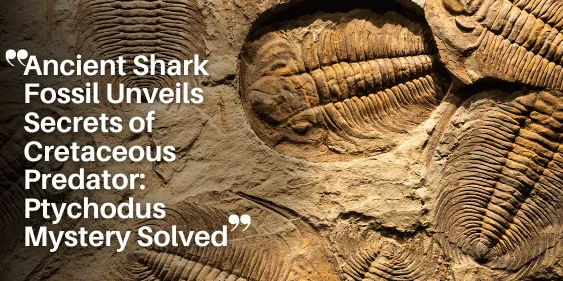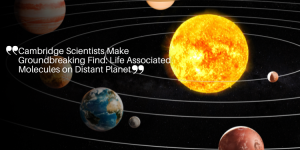Ancient Shark Fossil Unveils Secrets of Cretaceous Predator: Ptychodus Mystery Solved

Ptychodus is an ancient genus of shark that dates back to the Cretaceous Period.
What sets this genus apart from other prehistoric sharks are its distinctive crushing teeth.
Unlike the sharp, serrated teeth designed for slicing prey, the teeth of Ptychodus were large, rounded, and built to grind and crush hard-shelled marine creatures.
For many years, Ptychodus remained a mystery to scientists due to the limited fossil evidence.
Most of what was known about this marine predator came from isolated teeth, making it challenging to form a complete picture of its physical characteristics and its role in ancient marine ecosystems.
The enigma surrounding Ptychodus began to unravel with the discovery of a nearly complete fossil in northeastern Mexico.
This fossil not only included skeletal elements but also preserved an outline of the soft-tissue body, offering invaluable insights into the shark’s appearance and evolutionary traits.
The well-preserved fossil shed new light on various unknown aspects of Ptychodus and increased our understanding of its classification within the broader shark lineage.
Ptychodus belonged to the Lamniformes order, which includes the modern great white shark and other mackerel sharks.
Despite its unique crushing teeth, this genus exhibited features consistent with fast-swimming predators.
This combination was relatively rare and intriguing, hinting at a lifestyle and ecological niche that scientists had not previously envisioned.
Moving forward, these discoveries have set the stage for more focused research into the behavior, diet, and ecological role of Ptychodus.
Understanding these aspects will enhance our comprehension of ancient marine ecosystems and provide context for the evolutionary history of modern sharks.
Groundbreaking Fossil Discovery
Unraveling the Mystery
A major breakthrough came when nearly complete Ptychodus fossils were discovered in northeastern Mexico.
This exceptional find included six fossils, among which one was almost entirely preserved, revealing not just skeletal elements but a soft-tissue body outline too.
This rare level of preservation turned out to be a game-changer, unveiling features previously unknown about this ancient predator.
Preservation of Soft-Tissue
Shark skeletons are made of cartilage, which rarely fossilizes.
However, the conditions in the limestone quarries of Nuevo León were ideal.
The near-stagnant, oxygen-deficient environment preserved not only the hard structures but also the delicate outlines of soft tissues.
This unique preservation allowed scientists to get a more comprehensive view of Ptychodus, offering insights into its body shape and fin placements.
New Traits and Behaviors
This discovery corrected many long-held assumptions. What was once just a scientific guess regarding Ptychodus’ fast-swimming capabilities has now been substantiated.
The almost complete side view of the specimen depicted a streamlined body, suggesting it was not merely a bottom-dwelling, shell-crushing creature but a nimble predator.
The shark likely targeted larger prey like sea turtles and ammonites, suggesting it played a complex role in the marine ecosystem of the Cretaceous.
Evolutionary Insights
The fossils also placed Ptychodus firmly within the Lamniformes order, situating it among mackerel sharks, which includes modern great white sharks.
This classification helped clarify its evolutionary history, revealing that crushing teeth in fast-swimming sharks were more common than previously thought.
This groundbreaking find serves as a bedrock for understanding the ecological roles and evolutionary developments of ancient shark species, enabling us to appreciate the complex biodiversity these marine giants contributed to over time.
Evolutionary Classification
Relation to Modern Sharks
The groundbreaking fossil discovery in northeastern Mexico has provided pivotal information regarding the evolutionary classification of the ancient shark genus Ptychodus.
Ptychodus has been classified within the Lamniformes order, aligning it with modern great white sharks and other mackerel sharks.
This order also includes species such as megamouth, sand, goblin, and basking sharks.
The grouping is based on a detailed analysis of the fossil remains, including the unique shape and structure of the teeth and skeletal elements Fossil of an ancient shark that swam in the age of dinosaurs solves centuries-long mystery.
Unique Characteristics
Ptychodus sharks possessed a distinctive combination of crushing teeth and streamlined bodies, an unusual feature for fast-swimming predators.
This deviates from the modern durophagous (hard-shelled organism-eating) sharks, which are often smaller and less streamlined.
The crushing teeth of Ptychodus were essential for grinding and crushing shelled prey such as sea turtles and large ammonites, refuting earlier hypotheses that these sharks were primarily bottom-dwellers.
Evolutionary Significance
The discovery reveals that crushing teeth in fast-swimming predators were more common during the Cretaceous Period than previously thought.
As a member of the Lamniformes, Ptychodus shares a lineage with modern-day apex predators, offering unique insights into the evolutionary history and adaptability of sharks.
Their specialized teeth and significant size underscore the diverse evolutionary strategies that ancient sharks employed to dominate their marine environments.
Understanding Ptychodus’ evolutionary classification helps us appreciate the vast biodiversity within the shark family tree.
This insight lends crucial context to the study of ancient marine ecosystems and the evolutionary phenomena that have shaped the shark species we see today.
Let’s delve further into the size and physical characteristics of these fascinating ancient predators.
Size and Physical Characteristics
The prehistoric shark genus Ptychodus was a remarkable giant of the Cretaceous seas.
The largest species is estimated to have reached up to 9.7 meters in length, making it larger than today’s apex predators like the great white shark, which reach about 6 meters at most.
These ancient sharks were truly colossal creatures by any measure, setting them apart in the marine communities of their time.
Size Diversity
Ptychodus wasn’t a one-size-fits-all predator.
Fossil evidence suggests that there was a significant variety in terms of size among different species within this genus.
While some were true giants, others were more moderate in size, possibly indicating a variety of ecological niches.
For example, one fossil measured about 1.5 meters, likely from a smaller individual or possibly a younger shark.
Unusually Structured Teeth
One of the most fascinating aspects of Ptychodus is its distinctive teeth.
Unlike modern sharks that have sharp, cutting teeth, Ptychodus had extensive crushing teeth.
These teeth varied significantly among species, with some being large and polygonal and others featuring strange, rounded protuberances.
Combined, these teeth formed a massive tooth plate designed for crushing hard-shelled prey.
Exceptional Growth
Although there had been previous estimates that Ptychodus could reach even larger sizes, current fossil evidence places the maximum length at about 9.7 meters, which is still larger than the majority of modern shark species.
This substantial size likely afforded them significant advantages in both hunting and avoiding predators in the ancient seas.
Understanding the size and physical characteristics of Ptychodus opens up fascinating insights into its lifestyle and ecological role within the Cretaceous marine environment.
This giant crusher’s ability to dominate its habitat tells a story of a unique evolutionary path, one that set the stage for modern shark diversity.
Revised Understanding of Behavior and Diet
The evolved understanding of Ptychodus suggests that this ancient shark was a fast-swimming predator, challenging previous notions of it merely being a bottom-dweller.
The preserved fossil evidence found in northeastern Mexico reveals a streamlined body structure, indicative of an agile and active hunter.
This challenges earlier hypotheses that depicted Ptychodus as lethargic, prowling the ocean floor for easy pickings.
Diet and Predatory Behavior
Current evidence points toward a varied diet for Ptychodus.
The massive, crushing teeth and robust tooth plates of this shark made it well-suited to feed on hard-shelled marine creatures like sea turtles and large ammonites.
This characteristic aligns with its position as a top predator in the Cretaceous ocean.
The ability to crush and consume large, tough prey indicates an ecological role similar to some modern apex predators.
Implications for Extinction
The refined understanding of Ptychodus’ behavior and diet has broader implications for its extinction.
By hunting larger and more mobile prey, Ptychodus would have competed directly with other formidable marine predators of its time.
This competition may have contributed to its eventual decline.
As the Late Cretaceous seas became battlegrounds for limited resources, niche overlap and competition likely played significant roles in the extinction of these giant sharks.
This revised view of Ptychodus not only sets the stage for future research into this mysterious genus but also paves the way for deeper explorations into the diverse marine ecosystems of the Cretaceous Period.
Significance for Shark Evolution
The discovery of nearly complete Ptychodus fossils in northeastern Mexico has provided groundbreaking insights into the evolutionary history of sharks.
Classified within the Lamniformes order, Ptychodus is now understood to be related to modern mackerel sharks like the great white.
The unique trait of possessing large, crushing teeth in combination with a streamlined body reveals an unexpected diversity within the Lamniformes.
Evolutionary Insights
The revelation that Ptychodus used its crushing teeth not just for bottom dwelling but as a fast-swimming predator helps understand its evolutionary niche.
This combination of traits wasn’t seen in other mackerel sharks until this discovery, highlighting an evolutionary path previously unknown.
This shifts our understanding of shark lineage and diversification within the Cretaceous Period.
Biodiversity Revelation
Ptychodus’s existence broadens our knowledge of ancient shark biodiversity.
Previously, the lack of complete evidence left this ancient shark genus a mystery.
The preserved fossils show how Ptychodus adapted to various environmental conditions and competitive scenarios, enhancing our grasp on shark biodiversity over the last 400 million years.
Ecological Role
Understanding Ptychodus’s role in ancient marine ecosystems allows scientists to make better comparisons with modern ecosystems.
The shifts in diet and behaviors observed make clear the evolutionary dynamics that shaped not just shark species, but their prey and competitors.
This comprehensive view aids in painting a fuller picture of ecological ingenuity through the ages.
The continuous study of Ptychodus will doubtlessly lead to further discoveries, potentially uncovering more about its diet, ecological role, and the broader ancient marine biosphere.
As research progresses, we gain sharper insights into the majestic and complex history of sharks.
Future Research Directions
Further Investigation into Ptychodus Diet and Ecological Role
Understanding the diet and ecological role of Ptychodus is crucial for piecing together the ancient marine ecosystems it once dominated.
The new fossil discoveries have already shifted our perception of this ancient predator from a bottom-dwelling scavenger to a fast-swimming predator.
However, pinpointing its exact dietary habits remains an area ripe for exploration.
Future research will delve into comparing Ptychodus teeth with those of other known predators to determine the variations in wear patterns and feeding strategies.
Analyzing microfossils trapped in dental plaque could also offer clues about what Ptychodus consumed.
Expanding our knowledge of its diet will help clarify its role in the Cretaceous food webs, offering insight into how it competed with other large marine predators.
Potential for Discovering Additional Species
The existing fossil record of Ptychodus shows a range of species, but it’s likely that many more remain undiscovered.
Continued excavation in various geological formations known for preserving marine fossils is essential.
Areas with oxygen-deficient conditions, similar to those in northeastern Mexico, could yield additional well-preserved specimens.
Paleontologists will focus on both new digs and re-evaluations of previously collected specimens, which might have been that overlooked.
Researchers also aim to refine the classification criteria for Ptychodus species.
Detailed morphological studies, coupled with advanced imaging techniques like CT scans, could help identify subtle differences among species that simple visual inspections might miss.
Discovering more species would provide a more nuanced understanding of the genus’s evolution and adaptations.
Importance in Understanding Ancient Marine Ecosystems
Studying Ptychodus not only enriches our knowledge of its genus but also helps illuminate the broader marine ecosystems of the Cretaceous Period.
These sharks played pivotal roles in their environments, their behavior and physiology impacting the marine community structure.
Understanding these dynamics can reveal how ecosystems responded to environmental changes, both biotic and abiotic.
By examining the interactions between Ptychodus and other marine life, scientists can better understand extinction events and ecological shifts.
This research is vital for reconstructing ancient climates and oceanography, offering lessons applicable to current climate change scenarios.
Future research on Ptychodus, therefore, offers the dual promise of deepening our understanding of both this remarkable predator and the ancient oceans it inhabited, providing a richer picture of our planet’s evolutionary history.







